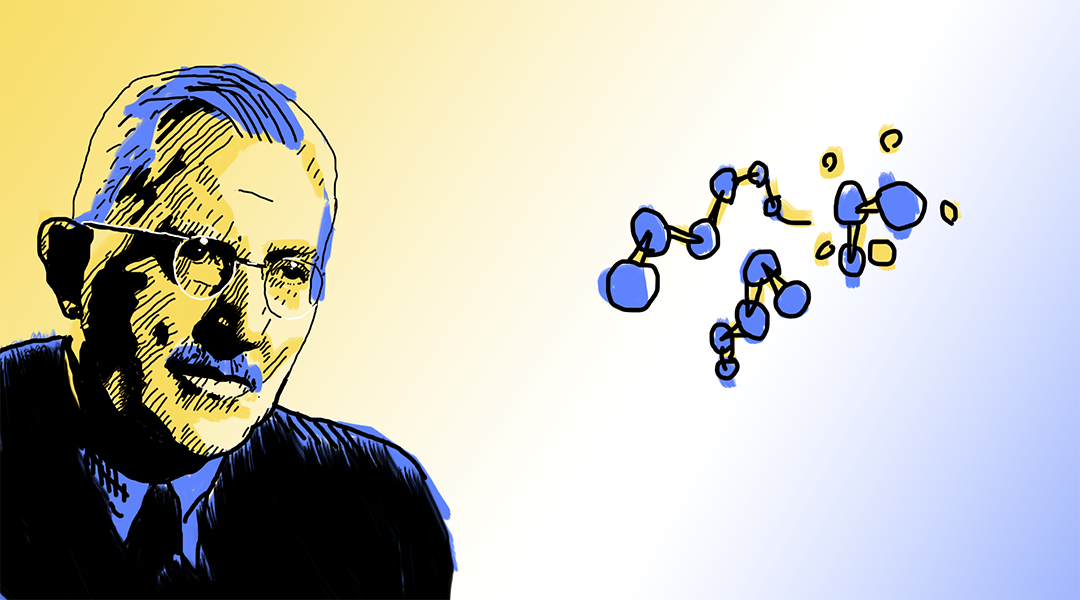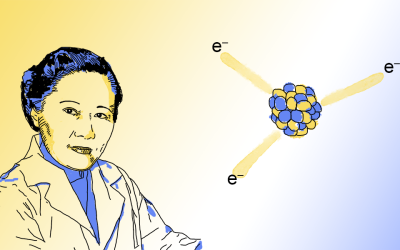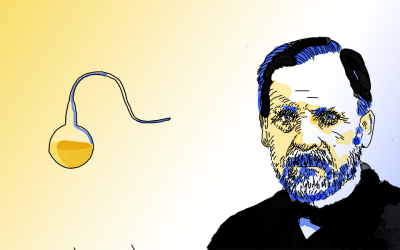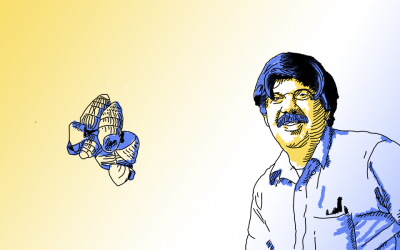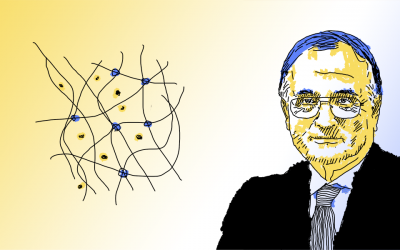Image credit: Kieran O’Brien
One hundred years ago this month marked the beginning of a revolution in chemistry and materials technology. On June 12, 1920, an organic chemist then working at the Swiss Federal Institute of Technology in Zurich, published a paper that would change our understanding of chemistry forever, and pave the way for the proliferation of synthetic materials that were to have profound impacts on the modern world; construction, manufacturing, packaging, biology, medicine, and much more were changed irrevocably by humankind’s sudden mastery of a new chemistry no longer limited to what nature had on offer.
This organic chemist was Hermann Staudinger, and his paper, Über Polymerisation (On Polymerization) was the first to propose that small units of molecules can bond covalently together in long chains known as macromolecules or polymers. Commenting on polymers in 1936, Hermann himself said “It is not improbable that sooner or later a way will be discovered to prepare artificial fibers from synthetic high-molecular products, because the strength and elasticity of natural fibers depend exclusively on their macro-molecular structure — i.e., on their long thread-shaped molecules.” But who was Hermann Staudinger, and why did this ostensibly simple description of macromolecules symbolize perhaps one of the most significant discoveries in 20th century science?
This edition of Pioneers in Science looks at the life and work of Staudinger, highlighting his impact on 100 years of polymer science, and sees where polymer science is now and where it might be going, as concerns about microplastics and plastic waste have spurred new branches in this field better equipped for the challenges of this century as we learn lessons from the last.
Beginnings
Hermann Staudinger was born in Worms, Germany, in 1881, at a time this young nation was going through rapid industrialization. Within a few years of its unification in 1871, Germany would become the dominant exporter in iron and a world leader in the growing chemical industry. Hermann, who initially had an interest in botany, was swept into this irresistible pull of the new industries and opted to study chemistry instead, obtaining his Ph.D. in 1903 from the University of Halle.
Signs of his greatness as an organic chemist were already apparent long before 1920. In 1905, at just 24 years old, Staudinger discovered ketenes, now a common compound known to chemists around the world. Over the next few years, as professor at the Technical University of Karlsruhe, he also successfully made synthetic alternatives to pepper and coffee, mostly in response to the shortage of these foodstuffs during the First World War.
Here we see a glimpse of Staudinger’s political views on science and its relation to society; he passionately believed that science should be used for the public good — even if it was something as modest as making an alternative to coffee that tasted just as good as the real thing in times of hardship — a view that put him at odds with his contemporaries during the war years. Fritz Haber, a friend of Staudinger whilst at Karlsruhe, expressed enthusiastic support for chemical weapons use by the German military, a position that Staudinger found abhorrent. He publicly opposed Haber, and in 1919 even published a paper in French in a journal by the Red Cross expressing ideas concerning technology and war.
With the horrors of the war over, doubtless a huge relief for Staudinger and many others, the world awoke to the new decade of the 1920s with optimism. For Staudinger, little did he know that a problem he had been working on concerning high molecular weights of certain compounds would have a profound impact on what many hoped to be the dawn of a new, modern world.
Über Polymerisation
Before 1920, the chemistry community believed the exceptionally high molecular weights measured for certain compounds was the result of the molecules aggregating into colloids. This view was particularly espoused by Heinrich Otto Wieland and Emil Fischer (the one whom “Fischer projections” are named after), the latter having won the Nobel Prize in Chemistry in 1902 (Wieland would also go on to win the prize in 1927). But Staudinger disagreed on this colloidal explanation. His explanation is now a basic principle in chemistry today: Staudinger said that these compounds such as rubber, cellulose, and proteins were in fact a sort of paper clip chain, made up of a series of smaller, repeating chemical units, bonded to one another covalently. In other words, these were polymers.
Whilst he was respected among his peers and clearly a brilliant young scientist, it was quite a thing to be in open disagreement with mainstream scientific opinion of the day, particularly that of a Nobel laureate such as Fischer. Staudinger’s polymeric explanation for high molecular weights found in these compounds was therefore met with initial skepticism after Über Polymerisation was published in 1920. Wieland even gave the following advice to Staudinger; “Dear colleague, abandon your idea of large molecules, organic molecules with molecular weights exceeding 5000 do not exist. Purify your products such as rubber, they will crystallize and turn out to out to be low molecular weight compounds.“
Staudinger was not swayed, however. Following his first explanation of polymers, he and a colleague, J. Fritschi, published in 1922 the first direct evidence for the existence of long polymer chains in natural rubber. It is in this paper that Staudinger also gave the world the term “macromolecule”, which he himself described thus in 1924: “For such colloid particles, in which the molecule is identical with the primary particle, and in which the individual atoms of this colloid molecule are linked together by covalent bonds, we propose for better differentiation the name macromolecule.”
By the end of the 1920s, more and more researchers were finding evidence of the existence of polymers, vindicating Staudinger’s ideas, and Staudinger’s career began to reach new heights. In 1926, he started work at the University of Freiburg where he would remain for the rest of his career, and in 1927, married Latvian biologist and botanist Madga Voita, both of whom would collaborate to understand the role of macromolecules in biological processes.
Polymer chemistry takes over the world
By the 1930s, the understanding of polymers based on Staudinger’s work was in fashion, and researchers used this new description of polymers to better make synthetic polymers with good material properties. This new excitement led in 1936 to the creation of nylon, the world’s first commercially successful synthetic plastic. Its creator was the brilliant chemist, Wallace Carothers, working at the DuPont Experimental Section in Delaware. DuPont, like many other chemical companies around the world, were stimulated by Staudinger’s work on polymers. By 1938, the first toothbrush with nylon bristles was made. In 1939, the first nylon stockings were unveiled at the New York City World’s Fair, under the section “The World of Tomorrow”. By 1940, these nylon stockings were made commercially available and were an immediate commercial success, in part due to DuPont’s own marketing campaign, touting such claims that wouldn’t make it past the desk of modern advertising standards regulators such as being “as strong as steel, as fine as the spider’s web”. Clearly, synthetic polymers — or plastics, as the general public would come to know them by — were the material for a modern world.
But this apparent wonder material’s seemingly glamorous beginnings were soon eclipsed by the dark shadow the 1930s cast across the world. Global tragedies in the impending Second World War quickly turned people’s interest in polymers away from social benefit and instead toward military ends. This would no doubt have caused Staudinger great pain, and his views on science and war were not unnoticed by the Nazi regime that had by now taken power in his home country. Throughout the 1930s Staudinger was kept under tight surveillance, from being banned from leaving the country, to even being interrogated by the Gestapo in 1934. He was certainly incredibly lucky, however, that his pacifist views did not result in much worse for him, as it did for countless others — he was allowed to keep his post at the University of Freiburg, even founding Europe’s first research institute dedicated entirely to polymer research at Freiburg in 1940.
Staudinger’s legacy
Toward the end of World War Two, this institute was completely destroyed in the Allied bombing of Freiburg, but his work wasn’t.
It was for research published from his institute that he had already founded in 1939 the journal, Journal für makromolekulare Chemie (Journal for Macromolecular Chemistry), for which he was Editor-in-Chief. This was renamed after World War Two to Die makromolekulare Chemie (The Macromolecular Chemistry). The journal underwent another name change and lives on to this day as Macromolecular Chemistry and Physics, part of a family of “Macromolecular” journals that publish on a range of macromolecular topics from bioscience, theory, materials, reaction engineering, as well as rapid communications.
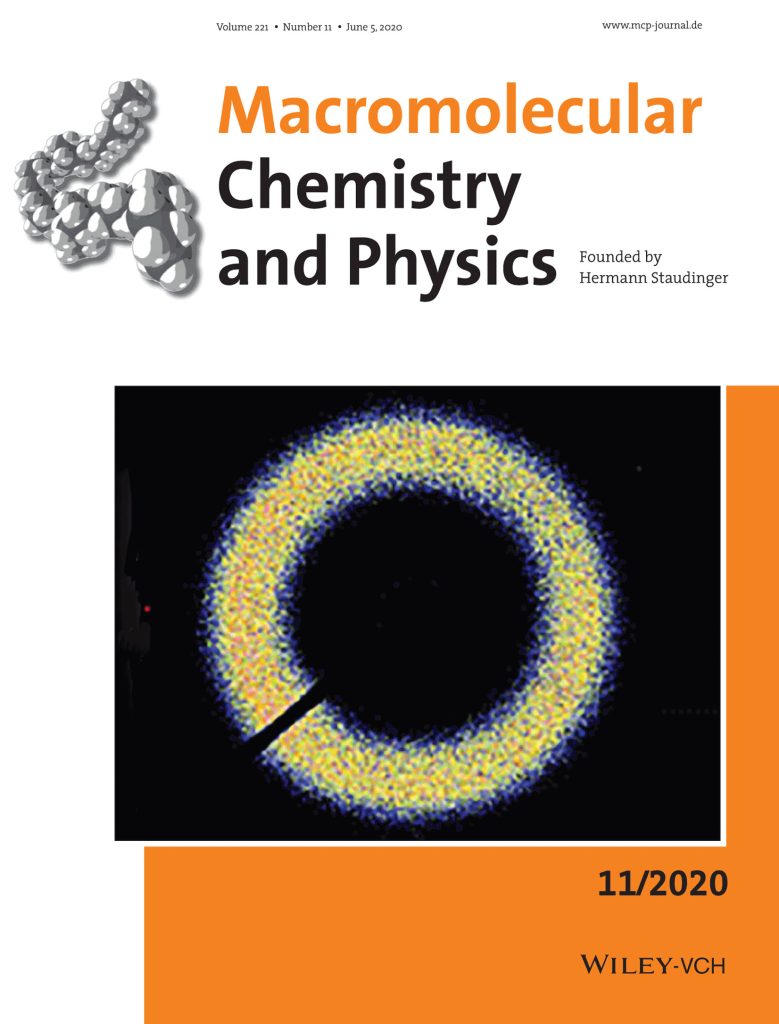
In the post-war years, the production of polymers refocused toward peaceful, civilian purposes, with global plastic production already reaching 1.5 million tons per year by 1950. This would only increase further as the years went on, and in 1953, Staudinger was awarded the Nobel Prize in Chemistry “his discoveries in the field of macromolecular chemistry.” In his acceptance, he acknowledged Magda as his collaborator. Indeed, as well as scientific collaboration, much of Staudinger’s other writings — which for political reasons couldn’t be made public in the war years — were edited and published by Magda in the postwar decades.
After his death in 1965, Magda continued to publish her husband’s work, and became president of the International Federation of University Women. She worked tirelessly for the recognition of women in science, and became president of the UNESCO German Science Commission to achieve these aims. Her own legacy was recognized in 1996 with her receiving the Grand Order of the Latvian Academy of Science Medal.
Where now for polymers?
Much has happened in the world of polymer science since 1920, and since 1950, the production of global plastics — with which polymers have long been synonymous — far exceeds the early days of 1.5 million tons per year; in 2019, over 350 million tons of plastic was produced on our planet.
What was once hailed as a wonder material has become an unprecedented problem material. The scourge of microplastics has made us seriously confront our responsibility to the natural world we are currently failing to protect. Microplastics have now been found in areas as “pristine” as Arctic sea ice. The production of such plastics themselves involves the extraction and burning of crude oil, which is helping to accelerate anthropogenic climate disruption. The strength of the covalent bonds binding monomers together to form polymers, that were hypothesized and validated by Staudinger a century ago, allow the creation of materials that are so chemically stable they could take centuries, if not millennia, to decompose in the natural environment. Despite this fact, visible, macro-scale sized plastics are being dumped in our waterways and posing an existential threat to marine life. All of this combines to form what scientists call the “anthropocene” — the geological epoch some think we are living in, named from the fact that our carbon emissions and plastic littering are having such a profound effect on the earth’s environment that evidence of our activities will be noticeable in the geological record millions of years from now.
We can probably safely say that Staudinger would not have liked to see the plastics his ideas helped to make being used in this careless way, particularly given the negative societal impacts climate breakdown has. But in the spirit of Staudinger’s conviction that science can also be used for the public good, this modern plastics problem need not be a reason to abandon polymer chemistry in the same way scientists are urging us to abandon fossil fuels.
There is still so much more that polymer science has to offer for our collective benefit, and a new generation of polymer scientists are actively researching to make new polymers that are sustainable, and not a danger to the natural environment. In recent years great progress has been made with bio-based polymers. We have previously reported on plant oil-based polymers being used to clean up oil spills and other chemical disasters, and researchers using bacteria-grown enzymes to break down existing plastic waste.
This year, Staudinger’s own journal, Macromolecular Chemistry and Physics, carries the torch of Staudinger’s legacy and has been looking toward this Brave New World of polymer science for the twenty-first century. In a special article series, “Polymers for the Future“, Laura Hartmann and Miriam M. Unterlass — from the Heinrich-Heine-University Düsseldorf and Technical University Vienna, respectively — along with the journal’s Deputy Editor, Mara Staffilani, give more insight into the exciting new work in the field of modern polymer science.
Polymers may have suffered a bad reputation since their halcyon days of a revolutionary new type of synthetic chemistry, owing to current pollution and over-consumption, but for better or worse, polymers are here to stay. But if Staudinger’s work is anything to go by, and the work being built on the back of his, then the future can be bright again for polymers, as we use them in ways that benefit society, correct and clean up the damage of the past, and give us the means to maintain and protect the future.
Perhaps in 2120, scientists will look back and celebrate some pioneering work done in 2020s that would go on to revolutionize eco-polymer chemistry.

